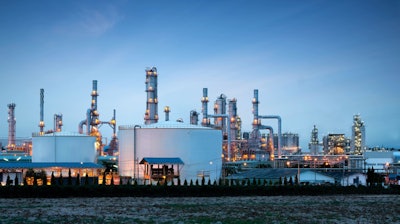
Manufacturing equipment often operates at temperatures ranging from below ambient to an intense 1,200°F (650°C) and above. Effective insulation remains necessary for asset and worker protection, energy efficiency and condensation control.
Today, the industry relies heavily on various mechanical insulation systems, such as mineral wool, calcium silicate, perlite, and aerogel. However, traditional mechanical insulation for industrial heat retention has its drawbacks. New silicone-based spray-on insulation coating offers several key improvements over conventional insulation. It is hydrophobic (repels water), can be applied in greater film thicknesses and has superior temperature resistance.
Due to its low thermal conductivity, the spray-on insulation coating's ability to significantly reduce surface temperatures, even at high temperatures, provides safe-to-touch surfaces with a single coat, offering enhanced worker protection.
Greater safety protection
Conventional waterborne acrylic or epoxy-based spray-on insulation coatings fail to serve equipment operating above 350°F (177°C). Newer silicone-based spray-on insulation coating can bridge the gap by offering greater temperature resistance. Thermal testing shows they endure continuous and cyclic temperatures reaching as high as 500°F (260°C), surpassing the 350°F limit typically associated with other insulation coatings.
Apart from withstanding temperature extremes, field applications and lab tests also confirm the silicone-based coating's low thermal conductivity. This property allows the coating to significantly reduce surface temperatures and minimize heat loss, even at high temperatures, providing energy efficiency as well as safe-to-touch surfaces. A single coat is enough to provide safe-to-touch surface temperatures per American Society for Testing and Materials (ASTM) standards.
For example, the PPG PITT-THERM 909 coating helps reduce the energy needed to maintain asset operating temperatures while protecting against accidental burns and injuries by reducing heat transfer to the skin.
Improved CUI mitigation
The new coating, being hydrophobic, resists water absorption better than many fibrous insulation materials. It absorbs less than 3% water when submerged after 72 hours, compared to much higher absorption rates in mineral wool. Lower moisture means increased insulation performance for greater operational efficiency.
The lower moisture is a significant benefit given that Corrosion Under Insulation (CUI) remains a critical challenge that incurs substantial costs, estimated at $2.2 trillion globally annually. The stakes remain high, as CUI can lead to costly maintenance, operational disruptions and severe accidents. In contrast, the enhanced silicone-based coating has shown exceptional promise in protecting against corrosion, partially due to their hydrophobicity.
The innovation, which can be applied directly to the metal without a primer, has successfully passed rigorous tests, including 1,440 hours of salt spray and 720 hours of water condensation, meeting the anti-corrosion performance requirements of the International Organization for Standardization (ISO) 12944-6 C5 high corrosion category standards. Even after being subjected to extreme conditions, including high heat, the coating exhibited minimal degradation, indicating its potential to mitigate the risks associated with CUI effectively.
Faster application
The commonly used waterborne acrylic or epoxy spray–applied coatings have limitations, particularly in coating thickness and temperature resistance. The application process for the coatings is often lengthy and laborious, especially for large-scale structures like petrochemical storage tanks. It's not unusual for 5–10 layers to be applied, each ranging from 20 to 65 mils (0.51–1.65 mm), cumulatively reaching up to 200 mils (5.1 mm) in total dry film thickness. The application of each layer, along with the necessary primer and potential topcoat, can span several days, extending the completion time to weeks. For example, each coating layer for petrochemical storage tanks can take up to multiple days to apply.
The newer coating can be applied in thicknesses of up to 250 mils (6.35 mm) per coat. Depending on the specific application requirements, only one or two coats are needed, substantially cutting down the time and cost of the insulation process. Despite the reduced number of layers, it can achieve a higher total coating thickness of 500 mils (12.7 mm).
In summary, this newer silicone-based coating represents a significant advancement in thermal management. It addresses the limitations of current insulation methods, offering a solution that is faster to apply, more durable and more protective of workers and assets.
 Nicole Rakers is a product development supervisor for the PPG Protective and Marine Coatings business.PPG
Nicole Rakers is a product development supervisor for the PPG Protective and Marine Coatings business.PPG
She has more than ten years of experience developing innovative solutions for customers, taking projects from conception through the stage-gate process to launch and post-launch support.























